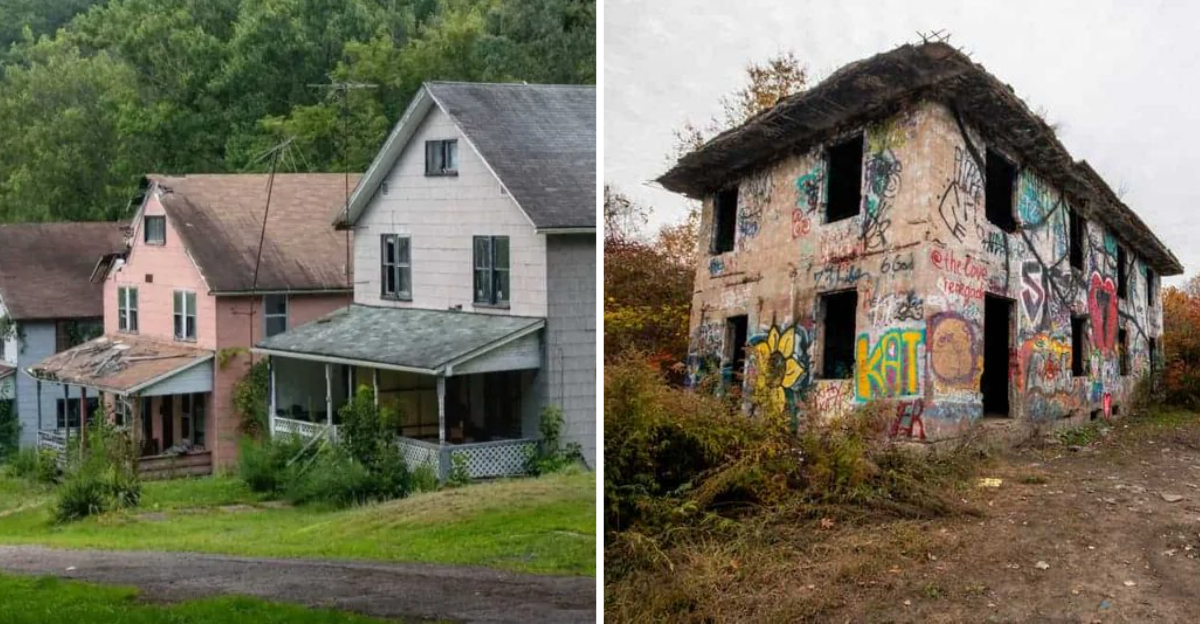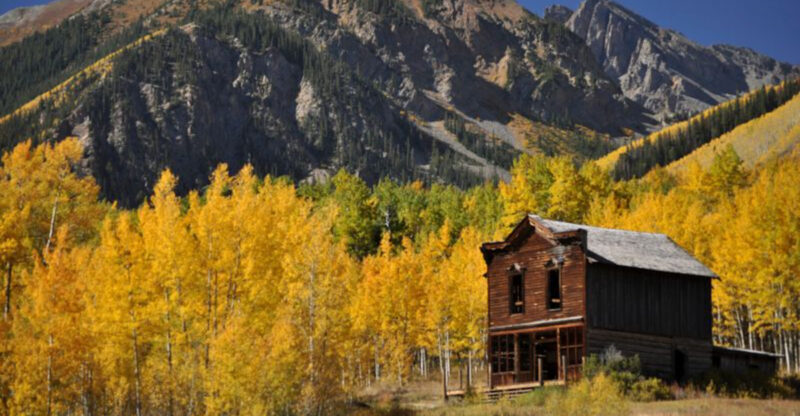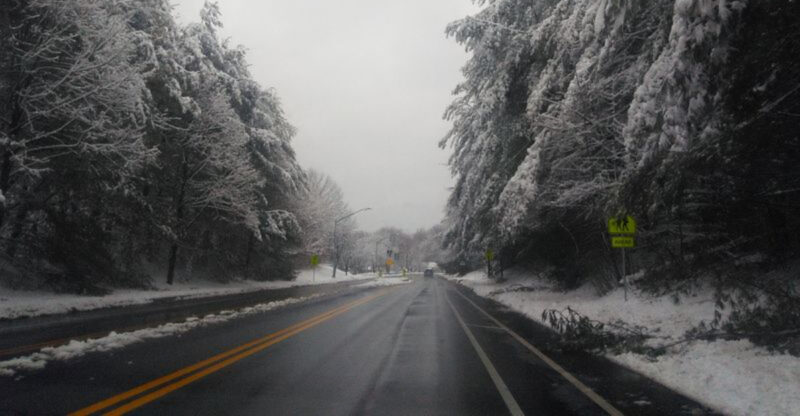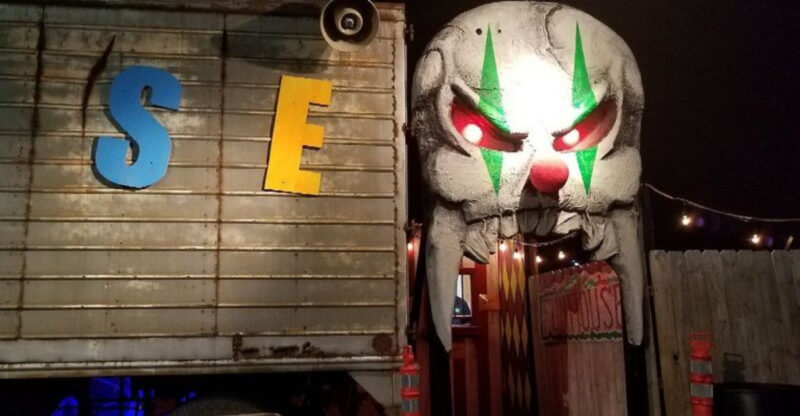15 Forgotten Pennsylvania Towns That Tell Haunting Stories Of The Past

Pennsylvania hides secrets beneath its rolling hills and forests, where entire towns have vanished from modern maps. These forgotten places once buzzed with life, filled with families, workers, and dreams, but now stand silent as reminders of a different era.
From underground fires to flooded valleys, each abandoned town carries its own haunting tale of why people left and what remains behind. Join me as we explore these eerie locations that whisper stories of Pennsylvania’s mysterious past.
1. Centralia: The Town That Burns Below
Did you know an entire town has been on fire since 1962? Centralia once thrived as a coal mining community with nearly 3,000 residents calling it home. Everything changed when a landfill fire accidentally ignited the coal seams running beneath the streets.
Smoke still rises from cracks in the pavement today, creating an otherworldly scene. The ground can reach temperatures hot enough to melt shoes, and toxic gases leak through the earth. Most families evacuated by the 1980s when the danger became impossible to ignore.
Only a handful of stubborn residents remain in this ghost town. Graffiti Highway, a colorful stretch of abandoned Route 61, became famous before being covered in 2020. Walking through Centralia feels like stepping onto another planet where nature and disaster collided.
2. Eckley Miners’ Village: Where Secrets Were Kept
Established in the 1850s, this company town housed coal miners and their families in simple wooden homes. Life here was tough, with long hours in dangerous mines and little pay to show for backbreaking work. The village became connected to the Molly Maguires, a mysterious group of Irish immigrants who fought against unfair treatment.
These men operated in secret, defending miners’ rights when no one else would. Some called them heroes while others labeled them criminals. Their story adds a layer of intrigue to Eckley’s already fascinating history.
Today, the village stands preserved as a museum where you can walk the same streets miners once traveled. Buildings remain frozen in time, showing how families lived during the coal boom era.
3. Fricks Locks: Colonial Ghosts by the Canal
Along the Schuylkill Canal sits a village that time forgot. Fricks Locks served canal workers and travelers during the 1800s when waterways were Pennsylvania’s highways. Beautiful colonial homes lined the towpath, and the community prospered for generations.
Everything shifted in the late 20th century when plans for Limerick Nuclear Power Plant required the land. Residents reluctantly packed their belongings and left their ancestral homes behind. Nature quickly began reclaiming what humans had built.
Overgrown paths now wind between crumbling stone structures that once sheltered families. Windows stare blankly at passersby, and doorways lead to empty rooms filled with memories. Hikers exploring the area report an unsettling feeling, as if the village remembers its former inhabitants and mourns their absence.
4. Wehrum: Lost in the Woods
Founded in 1901, Wehrum sprang up almost overnight when coal was discovered nearby. Within years, hundreds of miners and their families had built a thriving community complete with stores, schools, and churches. The town hummed with activity as coal poured from the mines.
When the coal ran out in 1929, so did Wehrum’s future. Families packed what they could carry and moved elsewhere seeking work. By 1934, not a single soul remained in the once-bustling town.
Forest has swallowed most evidence of Wehrum’s existence now. If you know where to look, you can find stone foundations and building outlines hidden beneath leaves and undergrowth. It’s haunting to imagine children playing where only deer roam today.
5. Livermore: Drowned Beneath the Dam
Imagine your entire hometown disappearing underwater. That’s exactly what happened to Livermore, a community established in 1827 along the Conemaugh River. For over a century, families farmed the fertile land and built lives in this peaceful valley.
Plans for the Conemaugh Dam spelled doom for the little town. In the early 1950s, residents received notices that their homes would soon sit at the bottom of a reservoir. Everyone had to leave, abandoning generations of memories.
When the dam filled, Livermore vanished beneath the water’s surface. Today, the reservoir covers where Main Street once ran and children once played. Only scattered remnants on high ground hint that a town ever existed here at all.
6. Alvira: Seized for War
World War II changed everything for this small farming community. In 1942, the federal government arrived with shocking news that Alvira would be seized under eminent domain. Families had just weeks to pack up and leave their ancestral farms for a military munitions plant.
Over 500 residents were forced out, their homes demolished to make room for weapons production. The government paid compensation, but money couldn’t replace generations of family history. Anger and heartbreak filled the air as moving trucks carried away entire lives.
After the war ended, the land was never returned to its original owners. Concrete bunkers and mysterious structures still dot the landscape where barns once stood. Local legends speak of ghostly figures wandering the old roads, searching for homes that no longer exist.
7. Yellow Dog Village: Company Town Forgotten
How quickly a town can disappear when its purpose ends! Yellow Dog Village sprang up in the early 1900s as housing for coal miners working nearby operations. The company built everything from homes to a store, creating a self-contained world for workers and families.
Life revolved entirely around the mine’s schedule and fortunes. When coal production slowed and eventually stopped, the company had no reason to maintain the village. Workers scattered to find employment elsewhere, and buildings were left to rot.
Today, you’ll need a good map and determination to find Yellow Dog Village’s remains. Collapsed structures peek through thick vegetation, and rusted artifacts hint at daily life. It’s a sobering reminder that entire communities can vanish when economic winds shift.
8. Scotia: The Mine That Exploded
Tragedy defines Scotia’s place in Pennsylvania history. This mining town seemed prosperous in the early 1900s, with families building lives around the coal industry. Then disaster struck in 1976 when a massive mine explosion killed multiple workers and shook the community to its core.
The explosion wasn’t Scotia’s first tragedy, but it proved to be among the final blows. Safety concerns and declining coal demand had already weakened the town’s economy. After the disaster, most residents decided they’d had enough and moved away.
Buildings still stand in Scotia, though nature advances steadily through broken windows and collapsed roofs. The mine entrance remains sealed, a silent monument to those who died. Visiting feels like intruding on a place where grief still lingers in the air.
9. Rausch Gap: Railroad Dreams Turned to Dust
Back in the 1850s, Rausch Gap buzzed with coal miners and railroad workers building Pennsylvania’s future. The town grew quickly around the mining operations, with homes, a hotel, and even a school popping up along the mountainside. But when the coal ran out in the 1900s, everyone packed up and left.
Today, stone foundations peek through thick forests, and old cemetery headstones mark where families once lived. Hikers on the Appalachian Trail pass right through this ghost town without even knowing it.
The silence is so complete that it feels like stepping back in time, where nature has reclaimed what people abandoned over a century ago.
10. Pithole City: America’s First Oil Boomtown Gone Bust
Imagine a town growing from nothing to 15,000 people in just five months! That’s exactly what happened in 1865 when oil was discovered near Pithole Creek. Hotels, theaters, banks, and newspapers appeared overnight as fortune seekers rushed in. The town even had its own post office that handled more mail than any other in Pennsylvania.
But the oil dried up just as fast as it appeared, and within two years, Pithole became a ghost town. Now it’s just empty fields with a few markers showing where buildings once stood.
It’s a powerful reminder of how quickly success can vanish when resources run out.
11. Concrete City: The Housing Experiment That Failed
Built in 1911 near Nanticoke, Concrete City was supposed to revolutionize worker housing. The mining company constructed 20 identical concrete duplexes to house their employees and their families. At first, it seemed like a brilliant idea fireproof homes that would last forever!
Unfortunately, the concrete walls made homes freezing in winter and sweltering in summer, and families hated living there. Within 13 years, everyone moved out, leaving the structures to decay.
Graffiti artists have since covered the walls, and the eerie rows of identical abandoned buildings create an unsettling atmosphere. It stands as a monument to good intentions gone wrong.
12. Austin: Swept Away by Disaster
Austin was a thriving lumber town with over 2,000 residents until September 30, 1911, when disaster struck. A dam upstream collapsed after heavy rains, sending a 25-foot wall of water crashing through the valley. Within minutes, the town was destroyed, and dozens of people lost their lives in the flood.
The survivors rebuilt Austin, but it never regained its former glory. Many original buildings were swept away forever, and the population dwindled as the lumber industry declined.
Walking through modern Austin, you can still see remnants of the old town and memorials to those who perished. The tragedy transformed this once-bustling community into a quiet reminder of nature’s power.
13. Masten: The Company Town Time Forgot
Hidden deep in the Pennsylvania woods, Masten served as a lumber company town in the early 1900s. Workers lived in simple houses provided by the company, and everything revolved around cutting timber from the surrounding forests. The town had a store, school, and sawmill that operated around the clock during peak seasons.
When the trees were all cut down, the lumber company moved on, leaving Masten behind. Now only concrete foundations, rusted equipment, and crumbling chimneys remain scattered through the forest.
It’s so isolated that few people even know it existed, making it one of Pennsylvania’s most forgotten communities where nature has almost completely erased human presence.
14. Lackawanna: Railroad Hub Reduced to Rubble
During the golden age of railroads, Lackawanna served as a vital junction where coal and passengers moved through Pennsylvania. The town boasted a massive roundhouse, repair shops, and rows of worker housing. Smoke from steam engines filled the air constantly, and the sound of trains never stopped.
As diesel replaced steam and highways took over from rail, Lackawanna’s purpose disappeared. The roundhouse was demolished, tracks were torn up, and families moved away seeking work elsewhere.
Today, only scattered brick walls and overgrown rail beds hint at the town’s former importance. It’s a sad example of how technology changes can leave entire communities obsolete and forgotten.
15. Helvetia: The Coal Patch That Vanished
Helvetia started as a small coal patch town where immigrant miners carved out a living underground. Families lived in identical company houses, bought supplies from the company store, and attended the small church on the hill. Life was hard, dangerous, and controlled entirely by the mining company that owned everything.
After the mines closed in the 1950s, Helvetia simply faded away. Buildings were torn down or collapsed, and the land returned to wilderness. Now only a few foundations and the old cemetery remain, where weathered headstones bear names of miners who never left.
It’s a sobering reminder of Pennsylvania’s coal heritage and the temporary nature of these communities.






